In the Beginning — 3
In 1888, the Department consisted of 160 officers, who staffed the stations, 121 of whom were patrolmen (including six mounted). Other members included one chief, one senior captain, three captains, five lieutenants, eight sergeants, one chief of detectives, four detectives, five drivers of patrol, four jailers, two bailiffs, three pound masters, and one driver of the horse-drawn wagon.
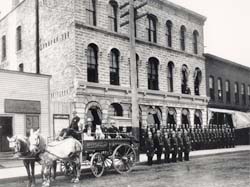 Central Station |
Prior to the advent of the substations, Central Station was located at Saint Paul City Hall, Fifth and Washington Streets. From 1889 to1911, it was located at 87 W. Third Street (now Kellogg Boulevard at Market). In 1911, it moved across the street to 110 W. Third Street and remained there until the 1920's when it was relocated to the courthouse.
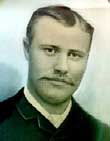 Hans Hanson |
The second name listed in the Police Hall of Honor is that of Officer Hans Hanson, who was murdered on August 3, 1888. Police records theorize that Hanson discovered burglars on the Barnum premises near the corner of Summit and Virginia Avenues, and in attempting to arrest them, he lost his life. A third name was listed shortly thereafter when Thomas McCarrick was fatally injured in a traffic accident involving a streetcar on May 21, 1891.
The Bell Charter was adopted in 1891, which gave the city $185,000 to spend annually for its Police Department. The legislature passed this necessary pension fund bill, regarded a large sum of money at the time. All police officers over fifty years of age and all widows and minor children of men who had seen twenty years of service in the Department were entitled to benefits. The fund was supported by taking ten percent of all the fines imposed upon prisoners in police court and those fines imposed by the mayor upon members of the police force. Retired police officers and widows drew a monthly amount equal to one-half of the salary received when on active duty, not exceeding $1,000 per year. After a few months, the fund was abandoned when the Supreme Court ruled it unconstitutional.
Saint Paul police officers in 1892 might have been a trifle too zealous with their night sticks. Chief John Clark issued an order which required all patrolmen who used their clubs to report to him. Failure to do so, it was said, would bring punishment, a fine or dismissal.
Mayor Frederick P. Wright was elected in 1892. He appointed a new chief of police and replaced the chief of the Detective Bureau, changes that had little effect on the various criminals and petty thieves. The mayor realized this in a personal way. On December 8, 1893, Mayor Wright heard a noise in the lower part of the official mansion. When he went down to investigate, he found a man crouching on the stairway. Joe Kennedy, a known thief, had falsely entered the mayor’s house. The mayor had locked him in a bedroom when he heard a voice outside calling, “Mr. Mayor, please come down here.” At the door was Sergeant Rose of the Rondo Substation. Rose had tracked the suspect to the residence and had come to warn the mayor. As the sergeant took the thief into custody, Mayor Wright asked Kennedy, “Weren’t you just a little bold?” The thief replied that he’d “just as soon go into the President’s house as the Mayor’s.”
During the last month of Mayor Wright’s administration, a lower crime rate was achieved with Chief Albert Garvin’s assistance. All the “bunco” men and thieves were put in the workhouse and all the “highway robbers” had either been jailed or ordered to leave town.
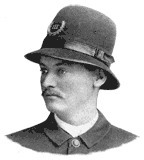 In the spring of 1893, a decidedly metropolitan look came to the
department when 150 felt helmets were purchased for $450.
In the spring of 1893, a decidedly metropolitan look came to the
department when 150 felt helmets were purchased for $450.
In 1895, the census report showed Saint Paul had a population of 140,292. Police salaries that same year were: chief $3,500, captains $1,400, lieutenants $1,200, mounted lieutenants $1,460, sergeants $1,000, mounted sergeants $1,260, patrolmen $900, mounted patrolmen $1,160, and Matron $600.
In September 1896, a Grand Army of the Republic (G.A.R.) encampment brought 100,000 visitors to Saint Paul. Some of these were shady characters who concerned Mayor Frank B. Doran. Newly appointed Chief Michael N. Goss marshaled his force, effectively planning ahead to meet all possible emergencies. The substations were drawn upon for half of their regular patrolmen, who were put on beats in the Central District. Those substation patrolmen were replaced by 100 “specials.” The Detective Division was strongly reinforced. The most serious criminal event that occurred during the encampment was a holdup in Smith Park. Both suspects were captured quickly.
The following is a letter written to Chief Goss from Mayor Doran after the G.A.R. encampment.
“The conduct of the St. Paul police force has been the topic of general commendation by our visitors and a source of great pride to our own people. As Chief, ex-officio, of the city, the praises that have been bestowed upon your courtesy, your vigilance and your efficiency by great numbers of people from home and abroad have been most gratifying. You have taken part in the greatest gathering of strangers ever witnessed in our northwestern country and have aided largely in making it a remarkable success. Your accommodating department has won you the enviable reputation of being in all respects the equal, if not the superior, of any department that has had to do with the order and comfort of our veterans during the past fifteen years, and, better than all, you have secured the admiration of our own people.”
In 1897, the 1891 police pension law was repealed by the legislature, the position of license inspector was created and, with officers requiring more speed and maneuverability, a twelve man Bicycle Squad was formed to patrol areas of downtown Saint Paul.
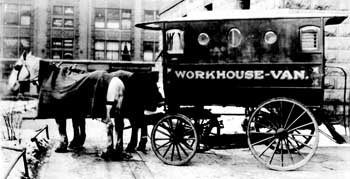 The “Black Maria” horse-drawn paddy wagon (workhouse
van) was built for the Department in 1897 for $300. Lost for some
time, this original wagon was located in a private collection in
Cleveland, Ohio. Purchased through a joint effort by the Department
and private donors, it was returned to Saint Paul in 1985, where it remains
today.
The “Black Maria” horse-drawn paddy wagon (workhouse
van) was built for the Department in 1897 for $300. Lost for some
time, this original wagon was located in a private collection in
Cleveland, Ohio. Purchased through a joint effort by the Department
and private donors, it was returned to Saint Paul in 1985, where it remains
today.
Soon after election, Mayor Kiefer was called upon to solve a Police Department dilemma involving recovered stolen property from pawnshops. A pawnshop owner required the police to pay for property found in his shop, even when the officer had proof that the property was stolen. Mayor Kiefer ordered Chief Goss to send an officer to seize stolen property, accompanied by its owner. Chief Goss declined, stating that the police had no right to take property away from a store. The mayor insisted and the property was taken forcibly. Chief Goss then asked for an opinion from a city attorney named Markham, who said, although the taking of the property wasn’t “...strictly legal, the mayor’s action was the only plausible one.” The attorney added that pawnbrokers should know the risk involved in advancing money on stolen property and be more careful in future dealings. Reportedly, property theft and pawning gradually decreased after this.
The following is a list of duties compiled by the Saint Paul Police Department in 1898:
| Accidents reported | 278 | Oil Lamps not lit | 3,172 | |
| Attempted suicides | 12 | Electric Lamps not lit | 61 | |
| Defective walks | 409 | Lost Children taken to parents | 177 | |
| Dead bodies found | 10 | Mad and Crippled animals killed | 344 | |
| Death by accident | 9 | Meals served prisoners | 4,073 | |
| Doors found open | 2,515 | Miles traveled by patrol wagon | 8,634 | |
| Insane Persons Cared for | 40 | Nuisances reported | 4,073 | |
| Cattle and Horses reported stolen | 7 | Runaway horses stopped | 122 | |
| Cattle and Horses reported lost | 229 | Sick and injured persons cared for | 224 | |
| Gas lamps not lit | 105 | Stray teams cared for | 45 | |
| Cattle and Horses cared for | 134 | Stolen vehicles recovered | 155 | |
| Suicides reported | 8 | Street lamps broken | 35 | |
| Sudden deaths | 8 | Stray horses taken up | 147 | |
| Vehicle reported stolen | 3 | Arrests made by wagon | 2,643 | |
| Box calls for wagon | 2,018 | Special calls for wagon | 1,236 | |
| Fire calls responded to | 423 | Extra duty performed | 796 days |
In 1899, a trial occurred where the question of a “police spy system” was examined seriously.
An owner of a rooming house objected to police officers wearing regular clothes when they entered and gathered information, which was then used against five rooming house owners. City Prosecutor Arnold argued that “...police officers acting as spies were sent out under orders and that the present method of exacting fines from disreputable people is not for the purpose of revenue, but because no other check to the spread of the social evil has ever been found.”
By the dawn of the 20th century, Saint Paul was quickly becoming a large urban metropolis. In 1880, Saint Paul's population had been slightly over 41,000. By 1900, waves of immigrants had swelled the population to 163,000. Railroads, such as the Great Northern and Northern Pacific which were headquartered in Saint Paul, provided year-round links with other parts of the country, ensuring a steady stream of people.
The city's boundaries extended far beyond the limits of earlier years. Electric streetcars carried people from their new outlying residential neighborhoods to work in downtown, while telephones linked businesses and homes. The modernization of the city posed new challenges for the Police Department, whose patrol officers now had to spread out among residential areas, a business district, industrial areas and parks. The first motor vehicles affected traffic problems, as they competed with pedestrians, horse-drawn wagons and streetcars for the right-of-way.
While industrialization and technology had revolutionized the way people worked and lived, many of the 19th century political systems endured. In the 1800s, Saint Paul's mayor appointed the police chief and other members of the Police Department. In the early 1900s, a Saint Paul Board of Police Commissioners appointed Saint Paul's police chief and officers. Yet, the board itself was appointed. Thus, political favoritism and changes in political offices continued to dictate who served on the force, especially when it came to appointing a chief.
By 1900, Saint Paul's residents demanded that city officials do something to curb a four-year crime spree. In the aftermath of the 1893 depression, thefts, burglaries, arson, murders and other crimes rose dramatically. Anticipating reform, citizens elected Mayor Robert A. Smith, who promptly fired the chief of police and certain other members of the Department. Smith then appointed John J. O'Connor as the new chief.
 Chief O'Connor |
Unlike some earlier chiefs, O'Connor was not a newcomer to police work. According to the book Men of St. Paul, O'Connor quit his clerical job in 1881 at the age of 26, reportedly because he did not like the monotony. O'Connor found more exciting work when he was appointed to the Police Department as a detective. Around 1886, Police Chief John Clark promoted O'Connor to chief of detectives. Clark liked O'Connor's policy of "organized crime with organized intelligence." O'Connor left the Police Department and returned several times between 1886 and 1900, depending on the politics of various city administrations. During the years when he wasn't in the Police Department, O'Connor ran his own private detective agency.
When Mayor Smith brought O'Connor back to the Police Department in 1900, he also appointed the first members of the new Saint Paul Board of Police Commissioners, which had been created by an act of the Minnesota legislature. O'Connor and the board moved swiftly to reorganize the Police Department. Among the reforms, O'Connor abolished the position of chief of detectives and assumed the added responsibility and control.
Chief O'Connor promised to rid Saint Paul of crime and set the Police Department's affairs in order. One of his main concerns focused on the snarl of vehicles in downtown. In 1901, O'Connor created the first Traffic Squad to control the city's congested streets. O'Connor also proposed that the Police Department add an ambulance and police surgeon. Then, as now, police officers often were the first ones at a scene where injured people needed medical attention. In the early 1900s, however, no one was trained or equipped to offer medical assistance.
To pay for the ambulance, the Saint Paul Police Benevolent Association held a benefit fund-raiser, challenging the Minneapolis Police Department to a baseball game. In June 1902, police officers dueled with bats at Saint Paul's downtown ball park, located between Robert, Minnesota, Twelfth and Thirteenth streets. At the end of the game, Minneapolis and Saint Paul split the proceeds. Saint Paul's portion was almost $1500, enough to fund a trip to Philadelphia to select and purchase an ambulance. When Saint Paul began ambulance service on September 12, 1902, it was the first police department in the region to offer on-scene medical assistance. Doctors George B. Moore and Paul Cook, the first police surgeons, attended to the injured day and night and provided a liaison with the city coroner. In 1914, a motorized ambulance replaced the horse-drawn vehicle. Queen and Dan, the two horses that had pulled the ambulance through rain and snow at all hours, retired.
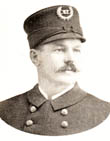 Officer C. Mayer |
On February 1, 1902, Officer Charles Mayer, a patrolman at the Rondo Substation, lost his life in the line-of-duty, becoming the fourth victim in the Police Hall of Honor. Hearing burglars in the rear of a saloon at the corner of University and Farrington, he went to investigate and was met by three men. One of them raised a revolver and fired, killing him.
In many ways, the duties of patrol officers and detectives in the early 1900s differed very little from today. Burglars broke into businesses and blew open safes, pickpockets snatched wallets, husbands and wives shot each other, children disappeared, forgers passed bad checks, traffic accidents injured passengers and pedestrians, despondent people committed suicide. At times, only the method of death or injury differed. Streetcars hit pedestrians, trains hit horse-drawn wagons, fire trucks collided with streetcars. Commonly, those who committed suicide either jumped from the High Bridge or drank carbolic acid.
In contrast, investigative methods differed dramatically from their modern counterpart. Formal training consisted primarily of reading the police manual and absorbing the advice of senior officers. The manual listed the duties of each rank, described methods for apprehending and arresting criminals and described the types of signals and techniques for operating the call boxes. Some manuals also listed city ordinances that police officers were expected to enforce.
Although new recruits relied on experienced officers for training, sometimes the manual offered more formal advice. Officers were instructed to carry a memo book, not to loiter, to be observant, to get to know the residents and businesses on their beat, to visit the courts and become familiar with the legal system. Timeless advice also included these enduring words:
“At the commencement, do not forget that in this business your character is your capital. Deal honorably with all persons, and hold your word sacred, no matter when, where, or to whom given... Lend a willing ear to all complaints made to you in your official capacity. The most unworthy have a right to be heard, and a word of comfort to the afflicted or of advice to the erring costs you nothing and may do much good... Remember that in your official duties you are continually and eminently exposed to the ten thousand snares and temptations of city life. As you value the character of the department to which you belong—as you value your own character and happiness, and the fondest hopes of your friends—beware! Be ever on your guard. Be not led into temptation.”

